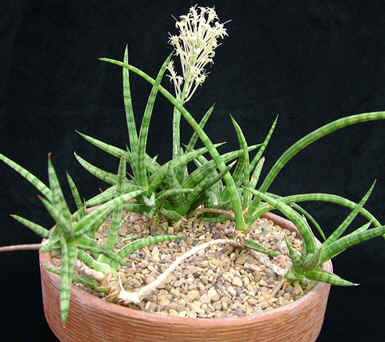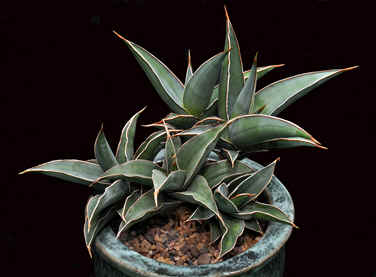Sansevieria
pinguicula, prize winner at the 2012 National Show.
Sansevieria
pinguicula
The
plant shown here won first prize
in the class for restricted pot size Sansevieria at the 2012 BCSS National Show, where it was
photographed by our illustrious roving editor, so many thanks to Trev for
capturing my plant so elegantly.
In my hands it’s a slow-growing plant, so is
ideally suited to the restricted pot class. I grow all my sansevierias as
house plants, so most have glazed or ornamental pots as shown here.
Plastic pots are a definite no-no for my sansevierias!
This species comes from Kenya and was first
described by Peter Bally in 1964. He named it pinguicula from the Latin pinguis meaning fat, and -cula
i.e. somewhat fat, for the fat leaves. These leaves are indeed very
succulent, thick and rounded on the under surface, with a broad channel
and distinct pale horny edge on the upper surface, tapering to a sharp
point, bluish-green in colour with no cross-branding. The plant branches
by producing above ground, raised stolons (runners) that are not covered
with sheaths, greyish in colour. The new growth then sends down roots into
the ground with the rosette raised above, thus making the plant look like
it’s growing on stilts, unfortunately not clearly shown in Trev’s
photo. From this the plant has the nickname of “walking sansevieria”.
In 2012 S.
pinguicula
subsp.
disticha
was named for its distichous (i.e. opposite) leaves at maturity (as
produced in many gasterias) as opposed to the typical subspecies shown
here in the photo, which has leaves arranged in rosettes.
The inflorescence is branched, which is
relatively unusual for a Sansevieria, since most have unbranched spikes, and the
flowers are very small. However, I’ve grown my plant for 8 years and it
has yet to flower.
Sansevieria
ballyi
The second Sansevieria closely associated with Peter Bally is very appropriately named after
him. The
original plant of S.
ballyi was collected by him in 1963 (Bally
12681) at Kivuko
Hill in SE Kenya. My plant shown in the photo is not from this collection
but came labelled as ‘Sansevieria sp. Voi’, but it does seem to match the
description of S.
ballyi fairly closely. Indeed Kivuko Hill is not far from the
town of Voi. Kivuko Hill is a rocky ridge within a large privately owned
ranch in Taita District, SE Kenya. The species was only named as S.
ballyi by Len Newton in 2004, although it has been in
cultivation for a while and is now reasonably common, but it is often
still encountered as ‘Sansevieria sp. Bally 12681’. Newton (2004) reports that S.
ballyi is plentiful on Kivuko Hill and is thus not
threatened.

Sansevieria
ballyi shown here in a 24 cm diameter pan. Photo: Colin
Walker.
